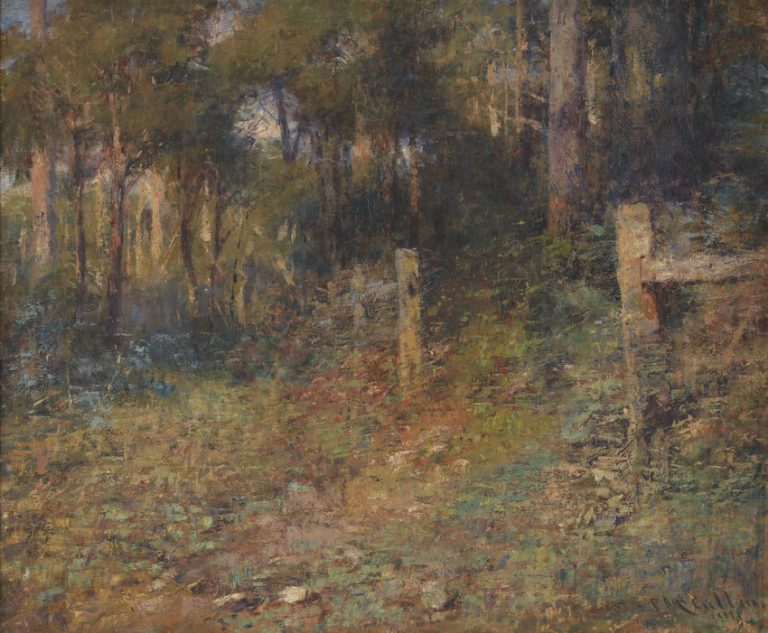We acknowledge the Traditional Owners of the land on which the Queensland Art Gallery | Gallery of Modern Art stands and recognise the creative contribution First Australians make to the art and culture of this country.

Frederick McCubbin / Australia 1855–1917 / The edge of the forest 1911 / Oil on canvas / 76.7 x 91.7cm / Gift of Lady Trout 1978 / Collection: Queensland Art Gallery | Queensland Art Gallery
Frederick McCubbinThe edge of the forest 1911
Not Currently on Display
In 1901, Frederick McCubbin acquired Fontainebleau, a cottage in the forests of Mount Macedon, Victoria, which he so named because it reminded him and his wife Annie of the forest of Fontainebleau in France. Mount Macedon was a favourite spot for the painters of the Heidelberg School and it is ‘the setting for many of McCubbin’s most famous works’.1
The artists of the Heidelberg School — among them McCubbin, Tom Roberts and Arthur Streeton — sought to capture fleeting atmospheric effects in their oil sketches. The group made excursions to Eaglemont and Heidelberg, an outlying area of Melbourne from which the group derived its name.
Endnotes:
1. Bettina MacAulay and Desmond MacAulay, The Behan Legacy: The Stuartholme-Behan Collection of Australian Art, University of Queensland Art Museum, St Lucia, p.111.
Frederick McCubbin was born in Melbourne in 1855. At the age of 14, he began work in a solicitor’s office, with his father hoping he would make the law his career. McCubbin, however, spent most of his time making model theatres. He also began studying drawing in the evenings at the Artisans’ School of Design in Carlton.
Recognising his son’s determination to become an artist, McCubbin Senior apprenticed him to a coach-maker where he learnt to paint emblematic and decorative designs. This apprenticeship ended in 1875 and McCubbin enrolled full-time at the National Gallery of Victoria’s art school, studying painting under Eugène von Guérard.
After the death of his father in 1876, McCubbin had to leave his studies to work for the family business. He continued to study painting at night at the Gallery art school, where he formed a friendship with fellow student Tom Roberts. In 1885, McCubbin helped Tom Roberts establish the first artist camp at Box Hill, and in 1889, contributed five paintings to the landmark ’9 x 5 Impressions Exhibition’, held at Buxton’s Rooms in Swanston Street, Melbourne.
Discussion Questions
1. Research your local environment and locate forests or national parks near your home or school. What art-related activities could you undertake in order to better understand these natural environments, e.g. drawing, photography, watercolour painting?
2. How does European Impressionism differ from Australian Impressionism? Identify historical differences to establish an understanding of contextual factors that influenced differences in technique.
Classroom Activities
1. Locate the township of Mount Macedon in Victoria on a map. Research the history of the town and its relationship to its surrounding environment. Combine your understanding of Mount Macedon’s location and history to illustrate a symbolic representation of the area.
2. Using a range of drawing media, make a study of The edge of the forest, paying particular attention to composition, line and shape. Compare your work with the original. What challenges did you encounter when you created your study?